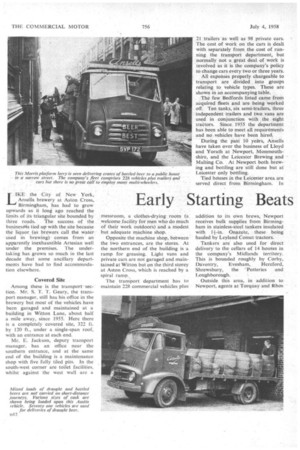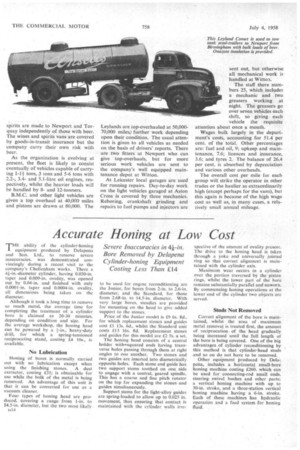Early Starting Beats Congestion
Page 58

Page 59

Page 60

If you've noticed an error in this article please click here to report it so we can fix it.
Many Drivers of Ansells Brewery, Birmingham, Begin Work at 6.30 a.m. to Get as Far Forward With Their Deliveries as Possible Before the Streets Are Filled With Traffic: Light Vehicles FavLured
By
C. S. Dunbar, minst.T.
IKE• the -City of New York, Ansells brewery at Aston Cross, -1-4 Birmingham, has had to grow upwards as it long ago reached the limits of its triangular site bounded by three roads. The success of the business tied up with the site because the liquor (as brewers call the water used in brewing) comes from an
apparently inexhaustible Artesian well under the premises. The under taking has grown so much in the last decade that some ancillary departments have had to find accommodation elsewhere.
Covered Site Among these is the transportsection. Mr. S. T. T. Geary, the transport manager, still has his office in the brewery but most of the vehicles have been garaged and maintained at a building in Witton Lane, about half a mile away, since 1955. Here there is a completely covered site, 322 ft. by 120 ft., under a single-span roof, with an entrance at each end.
Mr. E. Jackson, deputy transport manager, has an office near the southern entrance, and at the same end of the building is a maintenance shop with five fully tiled pits. In thesouth-west corner are toilet facilities, whilst against the west wall are a mess-room, a clothes-drying room (a welcome facility for men who do much of their work outdoors) and a modest but adequate machine shop.
Opposite the machine shop, between • the two entrances, are the stores. At the northern end of the building is a ramp for greasing. Light vans and private cars are not garaged and maintained at Wit ton but on the third storey at Aston Cross, which is reached by a spiral ramp.,
The transport department has to maintain228 commercial vehicles plus
21 trailers as well as 98 private cars. The cost of work on the cars is dealt with separately from the cost of running the transport department, but normally not a great deal of work is involved as it is the company's policy to change cars every two or three years.
All expenses properly chargeable to transport are divided into groups relating to vehicle types. These are shown in an accompanying table.
The few• Bedfords listed came from acquired fleets and are being worked off. Ten tanks, six semi-trailers, three independent trailers and two vans are used in conjunction with the eight traCtors. Since 1955 the department has been able to meet all requirements and no vehicles have been hired.
During the Past 10 years, Ansells have taken over the business of Lloyd and Yorath at Newport, Monmouthshire, and the Leicester Brewing and Malting Co. At Newport both brewing and bottling are still done but at Leicester only bottling.
Tied houses in the Leicester area are served direct from Birmingham. In
addition to its own brews, Newport receives bulk supplies from Birmingham in stainless-steel tankers insulated with 11-in. Onazote, these being hauled by Leyland Comet-tractors.
Tankers are also used for direct delivery to the cellars of 14 houSes in the company's Midlands territory. This is bounded roughly by Corby,
Daven try, Evesham, Hereford, Shrewsbury, the Potteries and• Lough borough.
Outside this area, in addition to Newport, agents at Torquay and Rhos (Colwyn Bay) take bulk supplies and are served once a week all the year round with extra journeys at peak times as necessary.
The Torquay vehicle (usually a 5-6tonner) draws a two-wheeled tanker in summer. A number of deliveries is made west of Bristol. Included in the fleet are 16 vehicles based at Leicester, 21 at Newport and one at Shrewsbury. The latter is run in connection with the company's maltings at that place.
Ansells also own mailings at Leamington and draw supplies of malt from Wellingborough. Two vans for carrying malt are included in the Birmingham-based fleet. The service between Leicester and Birmingham is usually maintained by Leicester-based vehicles which bring in empties each morning.
A great number of tasks has to be undertaken in the Midland area as not only are there the tied houses and the "free trade" to be supplied, but also deliveries to many private houses. A large business has been built up in. the supply of 2-gal. aluminium casks to householders. Future policy will be to use 30-cwt. vans with 2.2-litre oil engines for this work.
It will be observed from the fleet details that 12-14-ton vehicles are in the minority. This is because of the awkward situation of many delivery points, particularly in the older parts of most Midland towns. Even with three men, it is often a lengthy job to effect delivery and collect empties, and in many cases anything bigger than a 7-8-tonner would cause serious obstruction to other traffic.
As it is, the co-operation of the police has frequently to be sought to enable work to go on. Many drivers start work at 6.30 a.m. so as to get as forward as possible with the day's work before the streets are full with other traffic.
Draught and Bottled
It has been found best, too, so far as deliveries within about 10 miles of the brewery are involved, to keep bottled and draught beers separate. Normally 71 vehicles are allocated to draught and 51 to bottled. These mostly work on regular rounds as instructed by the loading department.
A transport foreman acts in liaison between loading and transport and calls for additional vehicle strength as and when required. Wines and spirits are sent out from a detached store. Twelve 2-4;ton vans supply wines and spirits to managed houses, clubs and so on.
These vehicles have side entrances closed by lockable shutters as well as the usual rear doors. The size of vehicles on this work is tending to increase. Journeys with wines and spirits are made to Newport and Torquay independently of those with beer. The wines and spirits vans are covered by goods-in-transit insurance but the company carry their own risk with beer.
As the organization is evolving at present, the fleet is likely to consist eventually of vehicles capable of carrying I-14 tons, 3 tons and 5-6 tons with 2.2-, 3.4and 5.1-litre oil engines, respectively, whilst the heavier loads will be handled by 8and 12-tonners.
B.M.C. and other light vehicles are given a top overhaul at 40,000 miles and pistons are drawn at 80,000. The Leylands are top-overhauled at 50,00070,000 miles; further work depending upon their condition. The usual attention is given to all vehicles as needed on the basis of drivers' reports. There are two fitters at Newport who can give top-overhauls, but for more serious work vehicles are sent to the company's well equipped maintenance depot at Witton.
At Leicester local garages are used for running repairs. Day-to-day work on the light vehicles garaged at Aston Cross is covered by three mechanics. Reboring, crankshaft grinding and repairs to fuel pumps and injectors are sent out, but otherwise all mechanical work is handled at Wittoa.
The staff there numbers 25, which includes a mechanic and two greasers working at night. The greasers go over seven vehicles each shift, so giving each vehicle the requisite attention about once a month.
Wages bulk largely in the department's costs, accounting for 5L4 per cent. of the total. Other percentages are: fuel and oil, 9; upkeep and maintenance, 7.6; licences and insurance, 3.6; and tyres 2. The balance of 26.4 per cent, is absorbed by depreciation and various other overheads.
The overall cost per mile for each group will strike the operator in other trades or the haulier as extraordinarily high (except perhaps for the vans), but this again is because of the high wage cost as well as, in many cases, a relatively small annual mileage.




























































































































